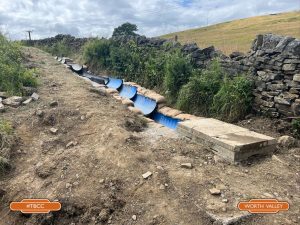The Keighley and Worth Valley Railway has made improvements to the drainage at Damems Junction to minimise erosion during periods of heavy rain.

The cutting above Damems Junction has a large amount of water flowing towards it from the surrounding land. At the crest of the cutting is a ditch that captures a lot of the water flowing towards the signal box, where it crosses under the track and into the River Worth. This drain provides an important function in capturing water on the slopes and reducing the chance of landslides.
Over the last five years, the railway has steadily improved the drainage in the area. The drain that crosses underneath the track has been improved, and a better connection from the ditch has been built. The ditch has also been extensively cleared and reprofiled so that it functions better, and some long-overdue maintenance has been completed.
Recently, the next stage of improvements was undertaken which was to repair one of the catch pits that was installed in 2017. It was found that the catch pit was not installed correctly. Excavations have been made around the catch pit so that a concrete surround can be installed, which will prevent water from seeping out of the catch pit into the surrounding ground.
At the same time, plastic channels have been installed into the ditch upstream. In this steep section of ditch, the ditch would be eroded during heavy rain, washing material into the pipes downstream. To prevent this and also try and reduce the velocity of the water, the plastic channels, with steps between them, will reduce the amount of energy in the water, thereby minimising the risk of erosion. This method has been used with success elsewhere on the railway.
The next improvement scheduled for the area is to install new track drainage from Damems Junction to approximately halfway to Oakworth. That will take a week and will be carried out during one of the railway's civil engineering weeks.